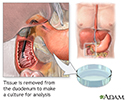Culture - duodenal tissue
Duodenal tissue culture
A duodenal tissue culture is a laboratory exam to check a piece of tissue from the first part of the small intestine (duodenum). The test is to look for organisms that cause infection.
How the Test is Performed
A piece of tissue from the first part of the small intestine is taken during an upper endoscopy ( esophagogastroduodenoscopy ).
Esophagogastroduodenoscopy
Esophagogastroduodenoscopy (EGD) is a test to examine the lining of the esophagus, stomach, and first part of the small intestine.

The sample is then sent to a lab. There it is placed in a special dish (culture media) that allows bacteria or viruses to grow. The sample is looked at under a microscope regularly to see if any organisms are growing.
Organisms that grow on the culture are identified.
How to Prepare for the Test
This is a test done in a lab. The sample is collected during an upper endoscopy and biopsy procedure (esophagogastroduodenoscopy). Ask your health care provider how to prepare for this procedure.
Why the Test is Performed
A culture of duodenal tissue is done to check for bacteria or viruses that may lead to certain illnesses and conditions.
Normal Results
No harmful bacteria or viruses are found.
What Abnormal Results Mean
An abnormal finding means that harmful bacteria or a virus has been found in the tissue sample. Bacteria may include:
- Campylobacter
- Helicobacter pylori
- Salmonella
Considerations
Other tests are very often done to look for infection-causing organisms in duodenal tissue. These tests include the urease test (for example, the CLO test) and histology (looking at the tissue under a microscope).
Routine culture for H pylori is not currently recommended.
References
Beavis KG, Charnot-Katsikas A. Specimen collection and handling for diagnosis of infectious diseases. In: McPherson RA, Pincus MR, eds. Henry's Clinical Diagnosis and Management by Laboratory Methods . 23rd ed. Philadelphia, PA: Elsevier; 2017:chap 64.
Dupont HL. Approach to the patient with suspected enteric infection. In: Goldman L, Schafer AI, eds. Goldman's Cecil Medicine . 25th ed. Philadelphia, PA: Elsevier Saunders; 2016:chap 283.
Fritsche TR, Pritt BS. Medical parasitology. In: McPherson RA, Pincus MR, eds. Henry's Clinical Diagnosis and Management by Laboratory Methods . 23rd ed. Philadelphia, PA: Elsevier; 2017:chap 63.
Haines CF, Sears CL. Infectious enteritis and proctocolitis. In: Feldman M, Friedman LS, Brandt LJ, eds. Sleisenger and Fordtran's Gastrointestinal and Liver Disease . 10th ed. Philadelphia, PA: Elsevier Saunders; 2016:chap 110.
Semrad CE. Approach to the patient with diarrhea and malabsorption. In: Goldman L, Schafer AI, eds. Goldman's Cecil Medicine . 25th ed. Philadelphia, PA: Elsevier Saunders; 2016:chap 140.
Siddiqi HA, Salwen MJ, Shaikh MF, Bowne WB. Laboratory diagnosis of gastrointestinal and pancreatic disorders In: McPherson RA, Pincus MR, eds. Henry's Clinical Diagnosis and Management by Laboratory Methods . 23rd ed. Philadelphia, PA: Elsevier; 2017:chap 22.
-
Duodenal tissue culture - illustration
A duodenal tissue biopsy is performed by inserting a special tube through the nose or mouth down into the duodenum. When the tube is in place, it suctions out some of the fluid located in the duodenum. When the procedure is over the tube is removed. The sample is sent to the laboratory for testing. The test is performed to see if a bacterial infection is present or if there are any other microoganisms present that could be causing infection.
Duodenal tissue culture
illustration
-
Duodenal tissue culture - illustration
A duodenal tissue biopsy is performed by inserting a special tube through the nose or mouth down into the duodenum. When the tube is in place, it suctions out some of the fluid located in the duodenum. When the procedure is over the tube is removed. The sample is sent to the laboratory for testing. The test is performed to see if a bacterial infection is present or if there are any other microoganisms present that could be causing infection.
Duodenal tissue culture
illustration
Review Date: 5/11/2016
Reviewed By: Subodh K. Lal, MD, gastroenterologist with Gastrointestinal Specialists of Georgia, Austell, GA. Review provided by VeriMed Healthcare Network. Also reviewed by David Zieve, MD, MHA, Isla Ogilvie, PhD, and the A.D.A.M. Editorial team.

